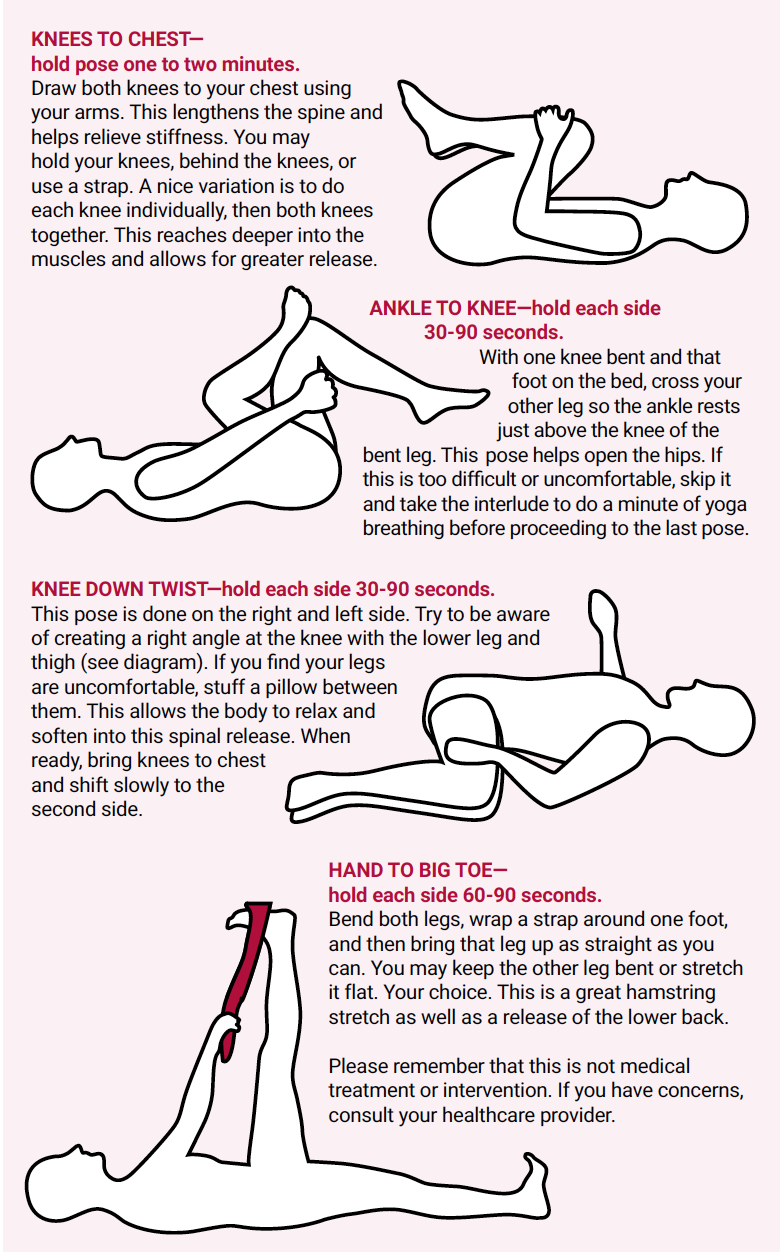by KATHY SENECAL, Cromwell, Connecticut
I became a yoga practitioner in the early 1990s, and over time I received certification and training in hatha and Svaroopa® yoga, taught classes, and ran workshops in those traditions for 10 years. I went on for advanced training as a yoga therapist, and after being diagnosed with FSHD, I began working with individuals with specific physical needs.
As traditional poses became difficult and harmful to my body, I found bed yoga beneficial and a way to maintain a practice. There is always a way to adapt and modify a pose, so yoga and yoga breathing can become part of a daily routine. These poses are designed to release the spine and provide the body/mind with the benefits of a yoga practice.
It’s important to remember to breathe throughout the stretches. I recommend three-part breathing: inhaling―chest, belly, abdomen; and exhaling―abdomen, belly, chest, like riding a long, slow elevator. You can also reverse the direction: inhaling―abdomen, belly, chest; and exhaling―chest, belly, abdomen. Whatever feels comfortable to you.
One of the benefits of deep breathing is that it oxygenates the blood and helps calm the mind. If you get tired of this yoga breathing, take a break and simply do natural breathing, following your breath as it goes in and out. Yoga breathing is traditionally done through the nose, but again, if this is uncomfortable, do what works for you.
The recommended time to hold poses is at your discretion. Listen to your body, and do what feels good. Holding for 30 seconds brings benefits. Remember, pain or discomfort with a pose signals it’s time to move out of the position and consider avoiding that position moving forward, depending on what your body is telling you. There are no hard and fast rules here, only guidelines, and, after all, you are in bed! Use any assists that work, from other people to pillows, straps, and anything in between.



Thank you for posting this. It is very usefull. I am a 75 year old woman with FSHD and in a wheelchair now for 14 years. I do some simple yoga exercises on my bed and I am glad with the exercises you posted.
Warm greatings, Clara
A few years ago,, the MDA paid for a once/yearly home visit by a PT.Among other things, she made suggestions to that helped my partner give me a shower, make me a little more comfortable sitting on the sofa, etc.
Times have changed. That MDA benefit is no more, and my FSHD has progressed a lot. How do I go about finding someone to make suggestions for my comfort sitting up and lying down? Positioning, cushions and the like. I live in the Los Angeles area
Any leads or advice appreciated. The only time I’m not really uncomfortable is while I’m asleep.
Thanks in advance.
Barbara
Hi Barbara, ask your doctor to prescribe a visit by an occupational therapist. That person would visit your home, check for potential hazards; make recommendations to improve your ability to function, be comfortable, and safe; and also assess you for other types of aids that could help.
Thanks, June. I will have to wait, I guess, because I have physical therapy in the works for other issues, and Medicare won’t let you go to >1 place at once. When it rains…
Barbara